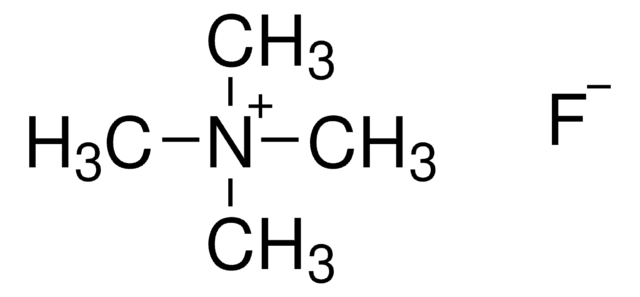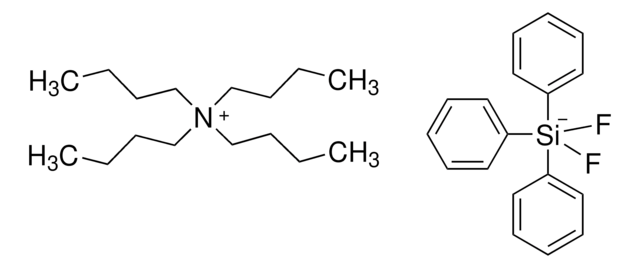241512
Tetrabutylammonium fluoride hydrate
98%
Synonym(s):
TBAF
Sign Into View Organizational & Contract Pricing
All Photos(3)
About This Item
Linear Formula:
[CH3(CH2)3]4NF·xH2O
CAS Number:
Molecular Weight:
261.46 (anhydrous basis)
MDL number:
UNSPSC Code:
12352116
PubChem Substance ID:
NACRES:
NA.22
Recommended Products
Quality Level
assay
98%
form
solid
mp
62-63 °C (lit.)
functional group
amine
SMILES string
O.[F-].CCCC[N+](CCCC)(CCCC)CCCC
InChI
1S/C16H36N.FH.H2O/c1-5-9-13-17(14-10-6-2,15-11-7-3)16-12-8-4;;/h5-16H2,1-4H3;1H;1H2/q+1;;/p-1
InChI key
UQCWXKSHRQJGPH-UHFFFAOYSA-M
General description
Tetrabutylammonium fluoride hydrate is known to be a source of F− anion, used in nucleophilic fluorination reactions.
Application
Reactant for preparation of:
- Double clathrate hydrates at high pressures
- Cellulose ethers
- Terminal olefins via dehydrohalogenation reactions
- Neutral and zwitterionic 3-carboranyl thymidine analogues for boron neutron capture therapy
Tetrabutylammonium fluoride hydrate can be used:
- To prepare 2,7-diethynyl-9-propyl-9H-carbazole, which is a key intermediate for the synthesis of calix[4]arene−carbazole polymers.
- As an anion source in the study of selective detection of F− by anion receptor viz Schiff base.
- To prepare terminal olefins from primary alkyl iodides
signalword
Danger
hcodes
Hazard Classifications
Eye Dam. 1 - Skin Corr. 1B
Storage Class
8A - Combustible corrosive hazardous materials
wgk_germany
WGK 3
flash_point_f
Not applicable
flash_point_c
Not applicable
ppe
Eyeshields, Faceshields, Gloves, type P3 (EN 143) respirator cartridges
Choose from one of the most recent versions:
Already Own This Product?
Find documentation for the products that you have recently purchased in the Document Library.
Customers Also Viewed
Naked-eye detection of F- and AcO- ions by Schiff base receptor
Dalapati S, et al.
Journal of Fluorine Chemistry, 132(8), 536-540 (2011)
Synthesis, 3085-3085 (2006)
Calix [4] arene-carbazole-containing polymers: Synthesis and properties
Barata PD, et al.
Reactive and Functional Polymers, 72(9), 627-634 (2012)
Hydrated tetrabutylammonium fluoride as a powerful nucleophilic fluorinating agent
Albanese D, et al.
The Journal of Organic Chemistry, 63(25), 9587-9589 (1998)
Sílvia Santos Pedrosa et al.
Macromolecular bioscience, 16(11), 1610-1620 (2016-07-28)
Hyaluronic acid nanogel (HyA-AT) is a redox sensitive crosslinkable nanogel, obtained through the conjugation of a thiolated hydrophobic molecule to the hyaluronic acid chain. Engineered nanogel was studied for its biocompatibility, including immunocompatibility and hemocompatability. The nanogel did not compromise
Global Trade Item Number
| SKU | GTIN |
|---|---|
| 241512-100G | 4061825407241 |
| 241512-10G | 4061825407548 |
Our team of scientists has experience in all areas of research including Life Science, Material Science, Chemical Synthesis, Chromatography, Analytical and many others.
Contact Technical Service









